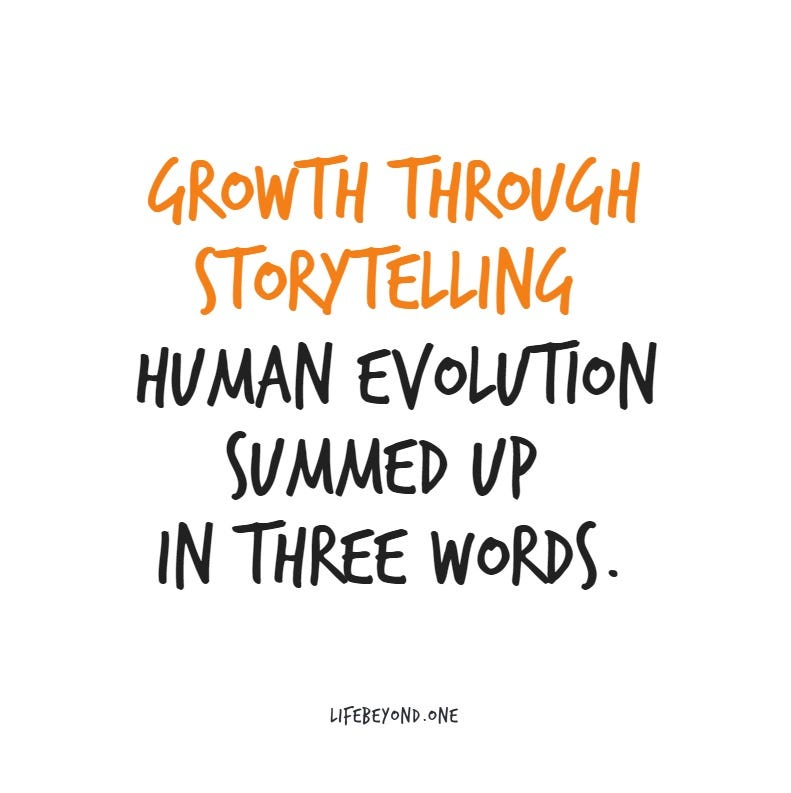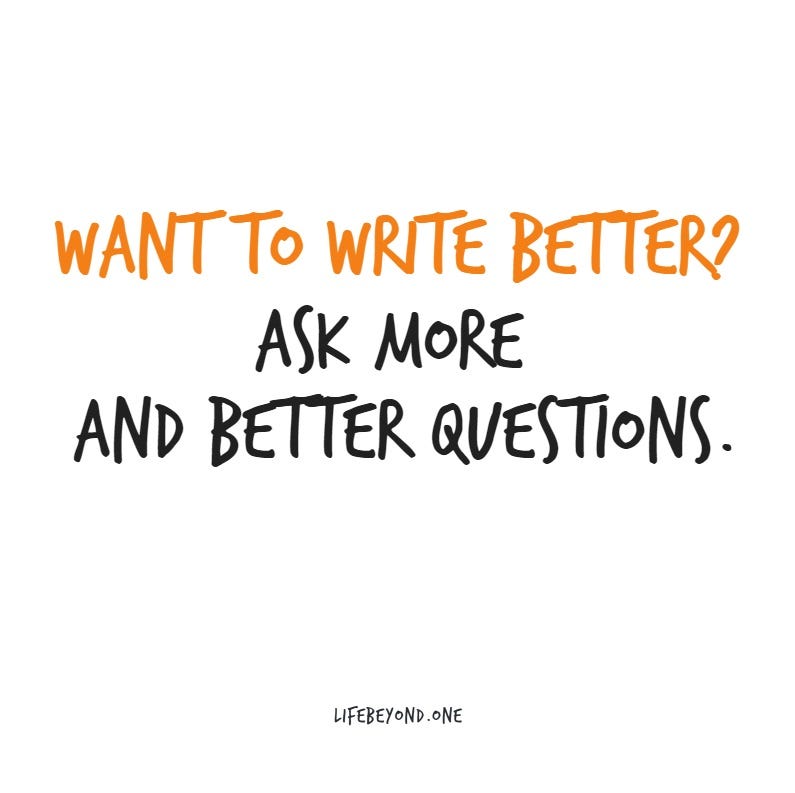How to Write Stories that are Felt, Remembered and turned into Action
The Storytelling Method that has helped tons of individual storytellers and brands reach their growth goals

Write what you mean. Speak from the gut, heart, and mind — combined strategically.
This is one of the most difficult things I’ve ever written. I’m about to teach you the basics of my storytelling method, that I’ve created over the 15 or so years that I’ve worked as a marketing writer and author. I want this to be fun. I want this to be crystal clear. I want this to be inspiring.
Oohh. Shudders. Exciting.
At the moment I’m writing this, I’m reading and responding to feedback from a WhatsApp group chat with esteemed former colleagues on the following question:
“If there was one thing you would like to learn from me when it comes to writing, what would that be?”
Turns out, these marketing and communication professionals that know me and my work like none other, would like to learn the following from me: how to keep writing fun, how to keep it interesting for yourself and others, and how to make sure stories are not just read or heard, but rather felt and experienced.
That’s exactly what you’ll learn here: how to write stories that are Felt, Remembered and then turned into Action — in a fun, fast and effective fashion. You will be able to use the basics you learn to base any and all communications on. Blogs, books, presentations, e-mails, even social posts — all can follow the below principles and steps.
Strap in, sharpen your pencil, and enjoy the ride.
Human storytelling and the five principles that make a story good
Let’s start off with some good news: if you’re reading this, you’re probably human.

That means it’s embedded in your DNA that you know how to communicate with other humans really, really well. You have it ingrained in your body, the structure of your brain and how you naturally think, to make sense of events and the world in the form of stories. And to listen to and tell stories. That’s great and a better place to start from than 99.99% of all other living things on this planet.
You know that a story has a beginning, a middle and an end. In business writing this basic structure translates to need, solution, result.
You know there’s some form of a tension arc built in to a good story. And you know that that tension needs to be felt. What else do you know about storytelling already?
We can summarize what makes a story a good story for humans in the following five points:
-
A good story is told with calm confidence
If only so you don’t distract from your main message. To be able to have fun with your audience and to really draw them into your story. To be able to be convincing at all: why should I trust you if you’re showing me that you don’t?
Confidence is based on preparation, and authenticity — knowing and trusting what you’re talking about. And confidence radiates from a clear structure, saying no more than necessary, and relaxed body language — both physically and on paper. -
A good story is made to be understood.
Make sure your main message or thought is worked out well enough to be intelligible to an intelligent 12-year-old. Check to see if it is. For example, with your significant other/partner who is a layman in your field. Or with an actual intelligent 12-year-old.
Build a structure that allows you to convey your main message clearly, based on a tension arc: from beginning, to change in the middle, to end. Omit any unnecessary background information — this is a very important one.
And make your language as simple and as visual as possible. Paint your story. Make us hear the background music, and smell the morning coffee. -
Made to be remembered.
Make sure your story stirs up a feeling. In order to do that, tap into the feeling that’s driving you to write the story in the first place. I’m purposefully listening to Mayra Andrade’s song ‘Lua’ as I’m writing this. Mayra Andrade is the Cape Verdean singer of our generation who’s taken over the torch from Cesaria Evora as well as Billie Holiday and Ella Fitzgerald. Listening to her sing makes me want to simply close my eyes and smile.
I hear the sunrise in her voice, and the Atlantic Ocean gently caressing the beach in São Vicente. Her music reminds me of how to make someone feel the story that you’re telling in their belly — even if they don’t understand your language.
Make your story a real story — with a main character — that is recognizable to your target audience. In order to do that, do the preliminary work of QLSD (more on this in a minute). What affects your audience? What is their frame of reference? What challenges or problems do they have to achieving their goals and what do they not yet know?
Have you asked them? I have. It takes less than two minutes to do so. -
Tells your audience something new
To stand out and be remembered, it is important for our brain that a message is new, or at least an element of that message. What’s new for your target audience? What don’t they know yet? What’s a new way of looking at a familiar problem that many of them haven’t tried yet? There’s always something new to be discovered, no matter how well we know our subject. Including if the subject is ourselves.
I want you to have fun writing, and to achieve that I want to challenge you to keep challenging yourself to renew your way of approaching writing. Turn your subject on its head. Literally, if you can. Approach it sideways, or through the eyes of a child. Approach it through the eyes of an alien visiting this planet. Have fun and allow yourself to find a new perspective.
This is what will help you to find new and inspiring ways of telling your stories continuously. Try writing in a different language for once. Doesn’t matter if you publish it. Try to have fun with rap or poetry, as an experiment. One of every 100 repetitions of the same thing may be ‘interesting’, but 1 out of 100 experiments will be a fundamental breakthrough. -
Sets people in motion.
Inspiring people is great — but what you actually want from your Stories is for them to help you achieve your goals as well as helping other people achieve theirs. That means you want to get people moving. But this is only possible if you also offer them a clear call-to-action.
Literally tell them what they can do, if they care and want to know more about what you are saying. Or if they have become convinced of your vision.
And this in turn is only possible if your own goals are very clear to begin with.
All of the above; clear goals, clear structure, knowing what your audience needs and wants — come from proper preparation. Which can literally be done in ten minutes, total. Excluding research.

Preparation, QLSD and 7-point structure: the 10-minute secret to awesome storytelling
In my story method, I assume you’ve already done any and all research that you might need to tell your story. I assume you already have all the knowledge and insights you want to share, at your disposal.
Preparation in my story method consists primarily of aligning the purpose of your story with the higher purpose you’re working towards — as well as the purpose or goals of the one who’s supposed to be reading or hearing your story; your audience.
What do you want to achieve with this story and how does it help you achieve your primary goal, your team goal or your company mission? Do you have strategic marketing or communication goals or do you work in an organization that has them? If so, how does this story contribute to those?
What is the feeling that you have around your subject, which you’re going to tap into to connect to your audience with? What emotion or sensation is driving you right now, this minute? What goals do people in your audience have? What are they feeling? How does the story you’re telling help them get there?
QLSD
So much of writing and storytelling is actually about listening.
QLSD in my method stands for asking Questions, Listening, Summarizing and Delving deeper. This is a practice that you can train everyday in common conversation, and that you get taught in psychology courses or in training to be a journalist. It’s a basic life skill and something you need to develop in yourself to become a better communicator and storyteller.
How to do that? It’s pretty simple, actually. Practice listening actively and with intent. Listen with your ears, but also with your eyes, your gut — and your mouth:
“[Sorry to interrupt, but] if I understand you correctly, what you’re basically saying is: ‘…[summarize what you’re getting from the other person here]..’. Would you say that’s an accurate way to state/summarize what you’re saying? What would you add or change? Why?”
Try this, or a variation of this wording, and give people back what you understand from what they’re saying, to check and improve your understanding of them. Trust me, it’s a game-changer in life in general.

The Seven-point Storytelling Structure
Now, how to build your story using that preparation and the QLSD technique? Here’s the framework I use — I even used it for this blog post— that I advise you to use in preparing to write your story and building its basic structure.
Notice that the first two questions are for you and summarize the above preparation; points 3–5 you literally put on paper to start building out your story.
This is the Seven-point Strategic Storytelling Structure:
- What is the subject I’m writing about?
-
What is the purpose of this story and how does it connect to my higher purpose and the goals of my audience? Did I ask them? [No more than 1–2 lines preferably.]
-
What is the main thought I want to share about the subject, and what’s the connected emotion?
[-> Summarize this as the first draft for your title. Your title should tell people What this is about, Who this is for, and what you’re Promising] -
What is my ‘hook’ or intro?
A ‘hook’ in storytelling is one to five lines with a new fact, a short story or anecdote; something that connects to the emotions you want to tap in to. -
What are my three supporting thoughts? [Summarize these as draft sub-headers]
What three points do I want to make to support my main argument/thought? What is a logical following order that builds your argument, and builds toward your goal of;
-
Conclusion and Call-to-action (CTA).
[If it makes sense or seems necessary; summarize your main thought and how you arrived at it, and:] literally tell the reader or listener what it is they can do if they are inspired. - [Short summary, for publishing, Search Engine Optimization and social sharing purposes]
Now, to actually write.
The above 10-minute preparation and structure make it possible to write a good blog article in 20 minutes. I know, I’ve timed it.
Fun writing (and strict editing)
Writing should be fun. For effective, fast and enjoyable writing I recommend a variant of the Yoopie method, from Joep Luycx at the Joepie Academy.
You can read more about the Yoopie method and how I apply it myself, here. The basis of this part of my method is that you de-couple freely writing down what you think and feel — from editing, which comes later.
After writing freely, edit strictly
Only starting after having actually written your story, can you be really critical of your writing. The most important thing here is to try to find the perspective of your reader or listener.
Read your first version, and continuously ask yourself: would this ‘click’ for the target group I have in mind?
Imagine that you are that specific person; your colleague, your boss, that customer you know reasonably well and on a personal level. If you’re them: do you get it? Can you follow it?
In addition, there are some basic tricks you can apply to improve your writing.
Are you using words that are (superfluously ->) too long or complex? Consider replacing all words with more than three syllables with something shorter. Are you using sentences that are too long and complicated? Two lines per sentence is a lot.
I recommend paragraphs of up to three to five lines, alternated with one-sentence paragraphs. White space is the written variant of silence and exudes calm and tranquility.
Finally — and you can check this with or without outside help: is your story correct, both in terms of content and structure, grammar and spelling? Does it read or listen away easily? And, perhaps more important than that:
Is it authentic and is the feeling you wanted to convey in it?
If so; congratulations. Your story is ready to be shared.
If you do is up to you.
Next step after that: collecting data and feedback on the reception of your story by your intended audience by — you guessed it: QLSD. And so the cycle continues.

Want to write more and better stories? Check out this one, brand spanking new AI content generator, Storylab.ai, which promises you more content and stories, faster, as well as teaching you to be a better writer.
